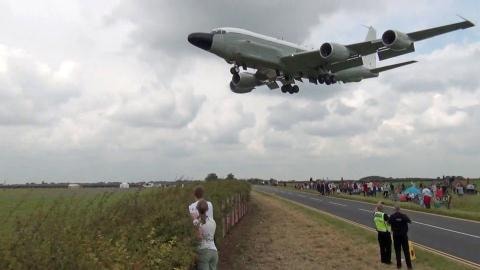US, UK, Israel join forces to find ways to destroy S-300
In recent days, the US, UK and Israeli Air Forces have continuously made moves to probe the reaction of Syria's S-300 before taking any hot action.
According to RT (Arabic version), on October 18, a US Air Force RC-135V aircraft flew hundreds of kilometers to the coast of Latakia province to scout out the S-300 air defense missile system that Russia had recently provided to Syria.
The US reconnaissance plane took off from Souda base, on the Greek island of Crete, and headed towards the Syrian coast. The US Air Force has yet to respond to the Russian media's statement.
However, RT believes that the unusual flight was intended to probe Syria's reaction and find a way to neutralize the S-300.
|
| RC-135W aircraft. |
And this was also the purpose of the Israeli and British aircraft before. However, the flight paths and approaches of these aircraft are different and especially more dangerous when they are forming a pincer to tighten the S-300 system of Syria from two different sides.
While the US RC-135W approached Syria from the Mediterranean Sea and the coast of Latakia province, the pair of RC-135Ws and the British Air Force's R1 Sentinel electronic warfare aircraft quietly entered Syria from Iraq - the area where the S-300 system was newly deployed.
It is known that before the British and American aircraft appeared, four Israeli F-16 fighters also took similar actions when they appeared for a short time in the sky near the city of Tripoli in Lebanon, a country that shares a border with Syria, to probe and evaluate the combat readiness of the S-300.
However, all movements of these aircraft were captured by the radar system of the Syrian S-300 complex. Russian media said that in case of any reckless actions by American, British and Israeli aircraft, the Syrian S-300 system was ready to fire.
The S-300's high combat capability is thanks to the C3I system in Syria that Russia has strengthened after the incident of the Il-20 reconnaissance plane being shot down by mistake. An important question that remains unanswered for the US and Israel is:
"Is the Syrian S-300 system fully integrated into the Russian C3I System or only partially and what is the Russian C3I System really like, what are its features"?
The basic structure of the C3I System is basically known to everyone, but what exactly Russia's C3I is is completely unknown to Western intelligence, especially after Russian military engineers have worked tirelessly for several months to upgrade it to connect with the S-300 systems in Syria.
This is the reason why the Syrian S-300 is much more sensitive in the task of detecting and capturing targets while the enemy cannot do anything even though they have tried to approach the S-300 from many different sources.
Therefore, even though the pincers created by the US, UK and Israel are still unlikely to be able to do anything to Syria's S-300.


